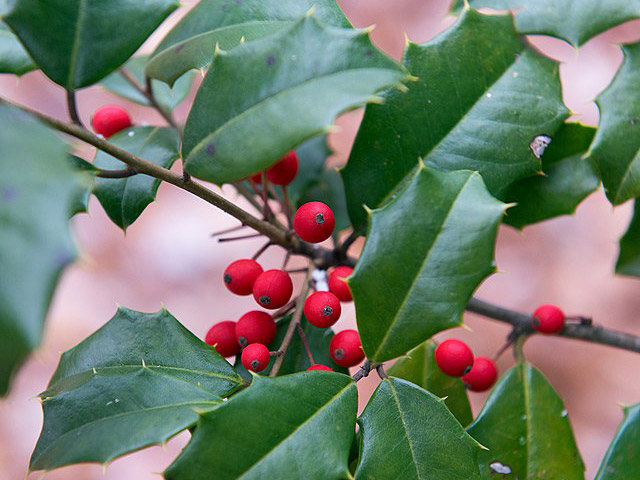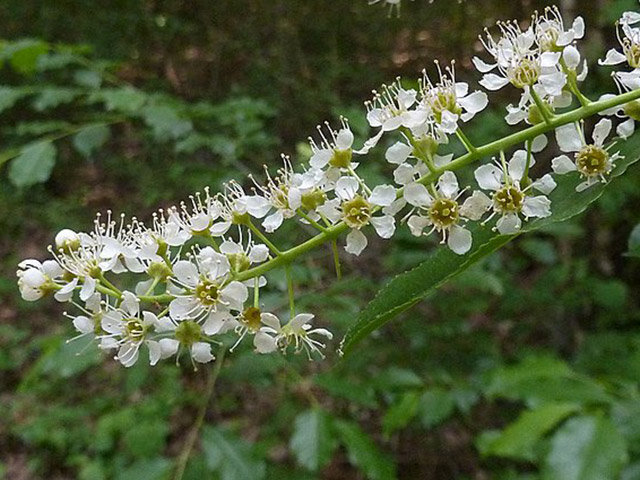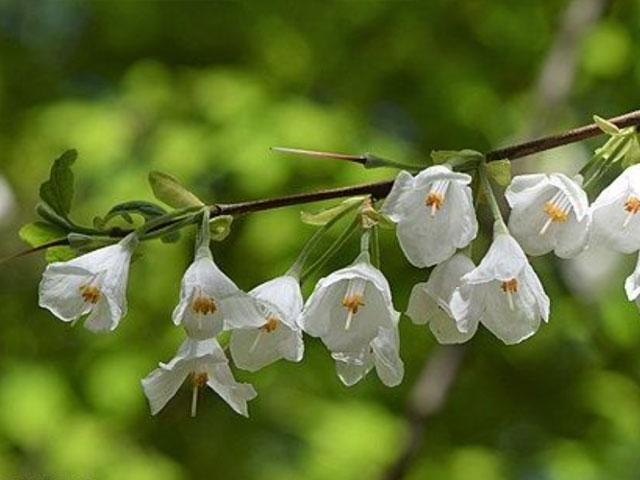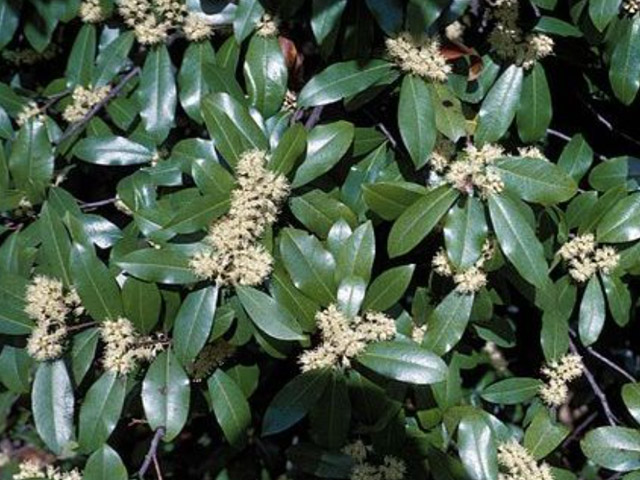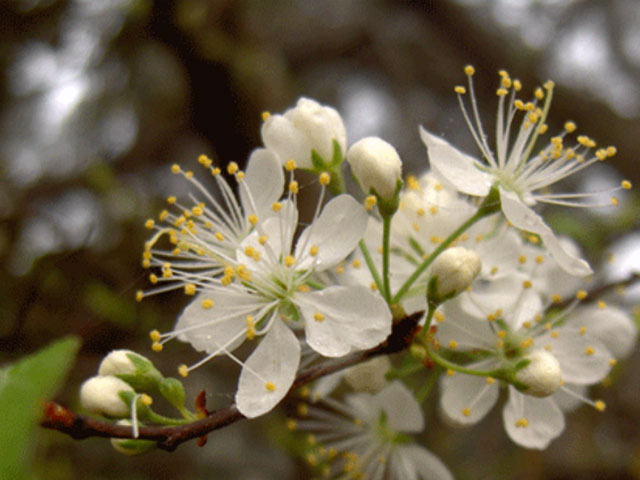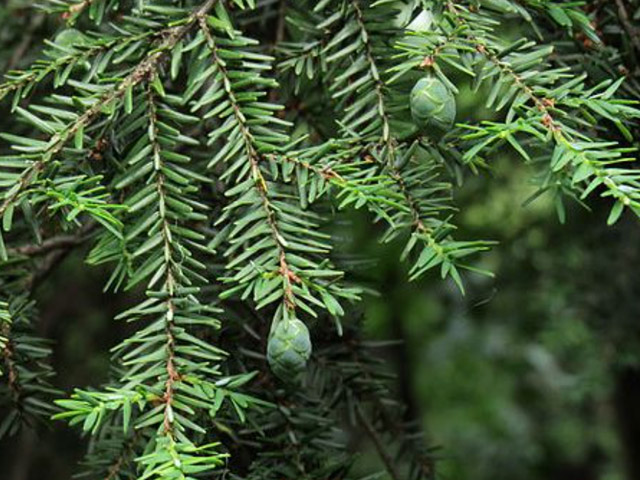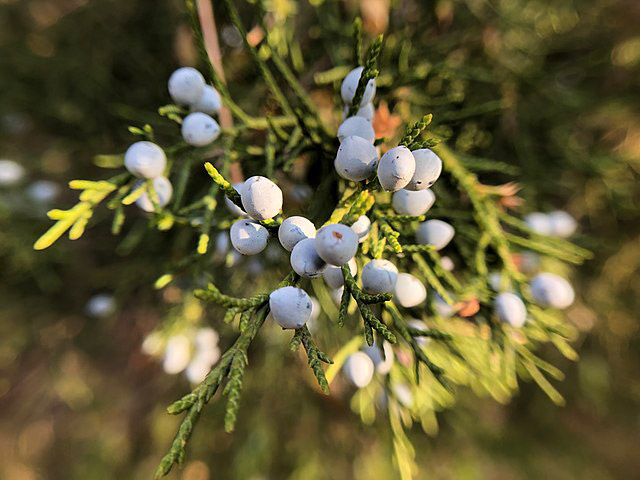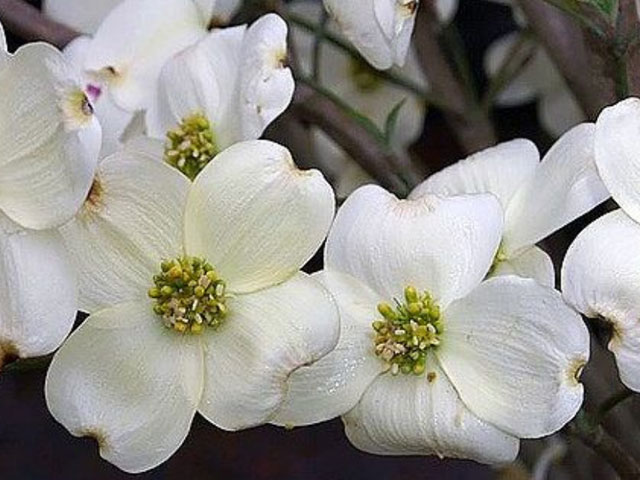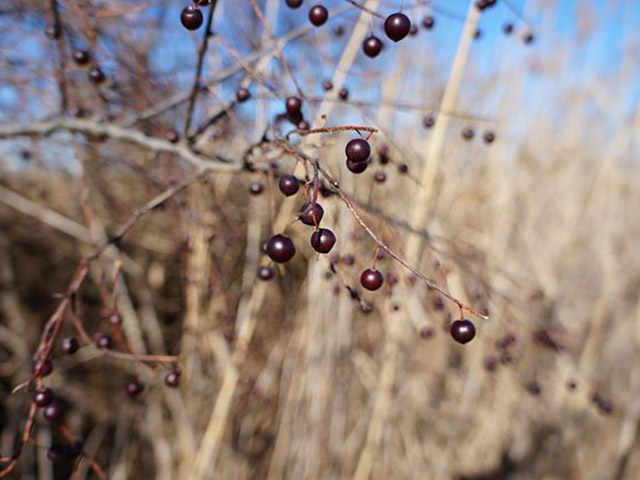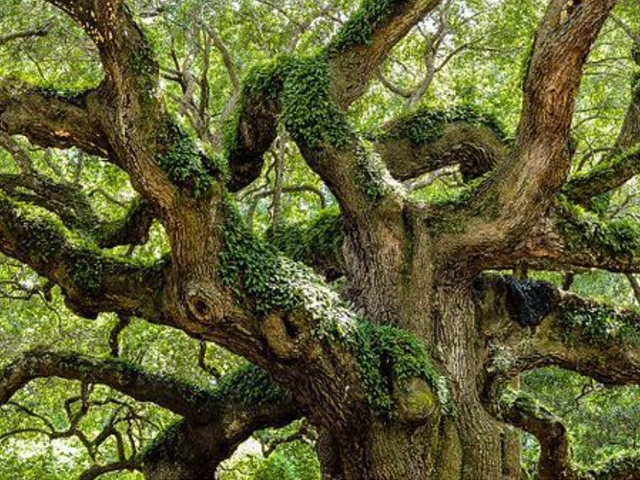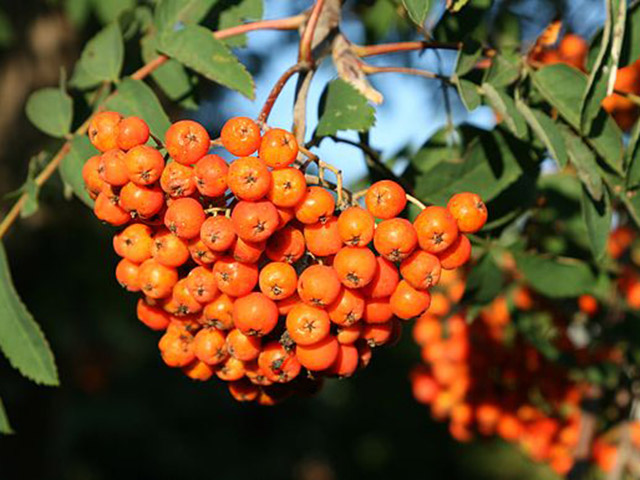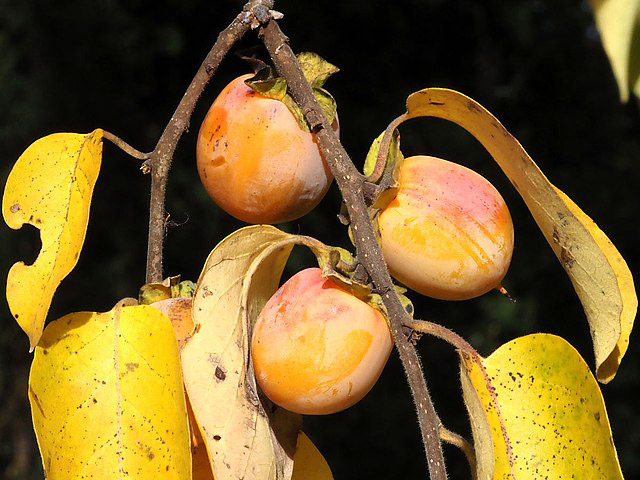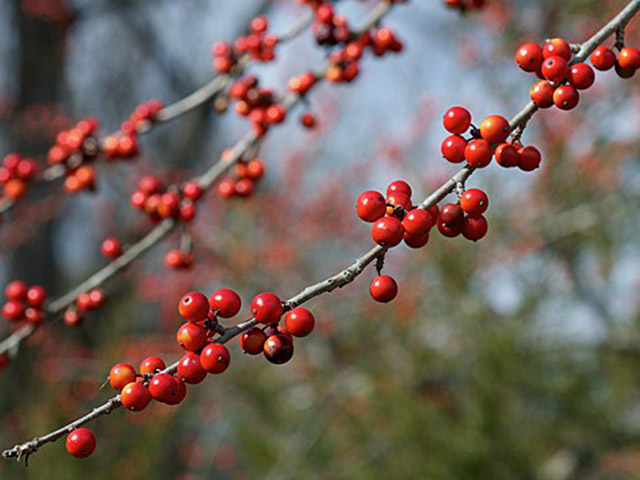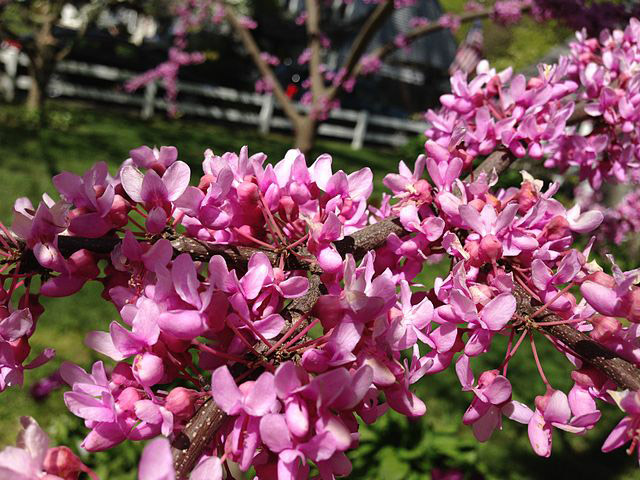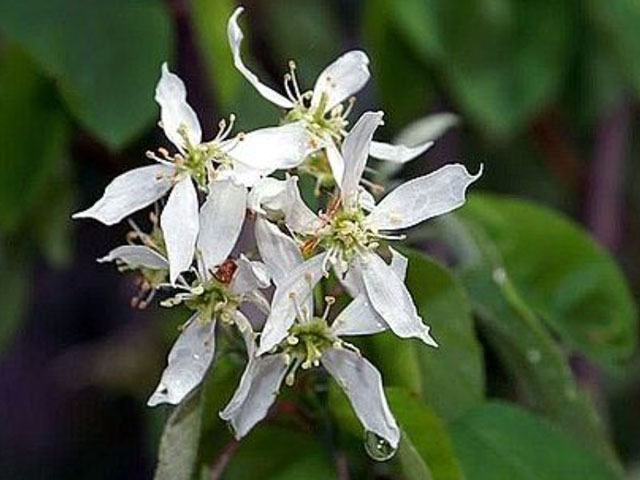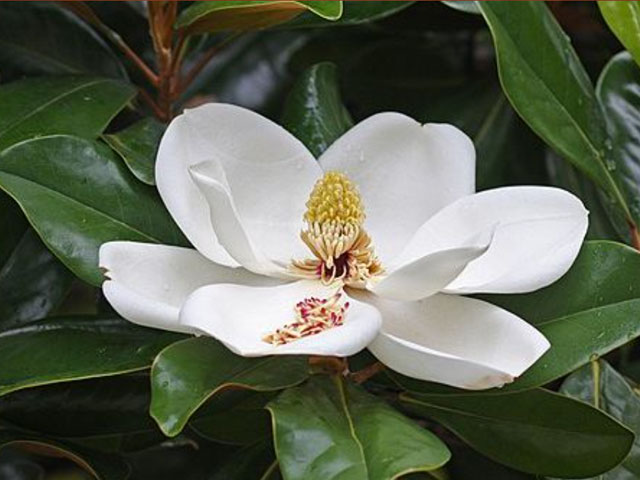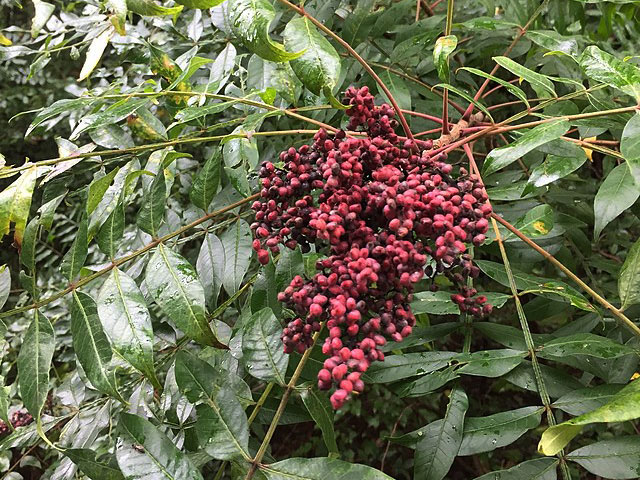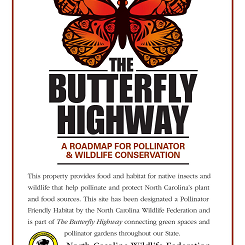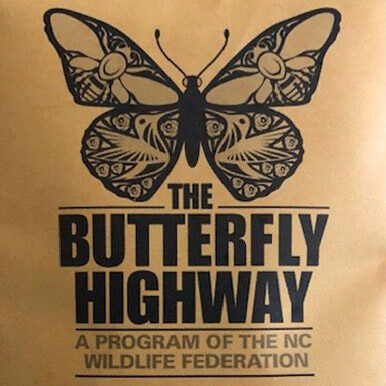Native Pollinator Trees
Recommended Trees for Wildlife
Native plants have a profound role in the environment. Trees are particularly valuable in providing habitat for wildlife. Not only do they offer shelter and places to raise young, but many bear fruit and seeds or harbor insects that sustain wildlife. A diversity of trees on your landscape provides food throughout the year for a variety of wildlife such as birds, mammals, lizards, insects and more.
In addition to providing wildlife habitat, trees benefit communities by increasing shade, improving air quality and filtering stormwater. Native pollinator trees often set deeper roots so they capture and filter higher amounts of stormwater runoff. This helps reduce flooding during extreme weather events and saves water since these require less watering after being established. Gardeners benefit because these plants are more resilient to drought, climate change and other adverse conditions.
Did you know? Dead wood is good! Dead trees, snags and logs benefit wildlife species that use nearly all their parts throughout stages of decay. As trees decay, they also nourish the soil and support microorganisms and neighboring plants. Dead wood also provides vital cover and places for wildlife to raise young. The oak family is the MVP of native trees and offers the greatest benefit for wildlife.
Below is a list of suggested trees native to the Atlantic southeast. Most of the trees listed can be found in all three regions of North Carolina (Piedmont, coastal, mountain). This list isn’t intended to be comprehensive and only highlights a selection of native trees that many nurseries and garden centers are likely to carry.
- See our list of native plants, trees, and shrubs you can add to your landscape by region of North Carolina
North Carolina Native Trees
American Holly
American holly, Ilex opaca, is a large, evergreen tree that is native to the central and eastern regions of North America. It commonly grows in woods or along stream and river banks.
While it is primarily an understory tree, American hollies can be grown in full sun or partial shade. They will grow in a wide range of well-draining soil conditions, but will falter in consistently saturated soils. American hollies are often planted in urban settings due to their tolerance for pollution.
In the spring and early summer, the American holly produces small greenish-white flowers that ripen into red berries in fall and winter. A male and female plant must be in close range to one another in order to produce the berries that will ripen on the female plant and persist on the tree through the winter.
The red berries really pop against the waxy, dark green leaves of the holly. The dense leaves provide great cover during the winter when most other trees are bare.
When flowering, American holly provides nectar for pollinators such as bees and butterflies. It is also the larval host plant for Henry's Elfin butterfly larvae which appear from February to May. The fruits are eaten by songbirds, wild turkeys, quail, white-tailed deer, squirrels and other small mammals. These berries are not edible for humans.
Due to its dense foliage and larger size, American holly is not always a great selection for small spaces, however, it serves well for creating privacy screens along property borders or in natural areas. This tree also adds texture and visual interest to pollinator gardens, winter gardens, and native plant gardens year-round.
Fun Fact: The leaves of American holly have sharp spines along the leaf margins.
Black Cherry
Black cherry, Prunus serotina, is a medium to large sized deciduous tree that is native to the eastern and central regions of North America. It can be found growing naturally in woodlands, thickets, old fields, and on stream side slopes.
Black cherry can be found in all parts of the state, with higher populations occurring in the mountains. They perform best when planted in full sun and moist, well-draining soil, but they will also tolerate partial shade and drier soils. At maturity, black cherry trees have pendulous, arching branches and may reach 60-80 feet in height.
From April to May, drooping racemes of white flowers appear on the terminal ends of the branches and glossy leaves follow shortly thereafter. The flower clusters attract an abundance of native pollinators, including bees and butterflies. The bark showcases orange-brown lenticels and the leaves have a characteristic orange fuzz on the backside of the veins. In fall, the leaves will turn yellow before dropping off the tree.
Black cherry is one of the most important native trees for wildlife in North Carolina. Dark purple berries ripen along the racemes in late summer to early fall to be readily foraged by songbirds, wild turkeys, quail, deer and other small mammals. Along with being a pollinator magnet, this tree is also the host plant for as many as 450 different insect species including tiger swallowtail, red-spotted purple and spring azure butterflies.
Black cherry is a great addition to woodland gardens, pollinator gardens and native plant gardens. It can also be planted as a specimen tree or shade tree, if desired. While the berries and inner bark of the plant are edible, other parts can be toxic to humans, pets and horses, so make sure to plant this tree in an appropriate location.
Fun Fact: Black cherry's wood is commonly used for musical instruments, tool handles and furniture.
Carolina Silverbell
Carolina silverbell, Halesia carolina, is a deciduous, small to medium sized tree or multi-stem shrub native to the central and southeastern United States. It can be found naturally growing on moist slopes, streambanks, and other rich woodland habitats. Although its native range is primarily in the mountains and Piedmont, it can be grown in all three regions of North Carolina.
Carolina silverbell grows anywhere from 10 to 40 feet tall, although most take on a shrubby, multi-stemmed growth habit. Carolina silverbell is best planted as an understory tree in moist, well-draining soil in partial shade. While it will adapt to full sun conditions, it will not tolerant heat or drought, so supplemental watering may be required on hot summer days.
Clusters of two to five bell-shaped flowers develop along its second-growth branches in spring. These dainty flowers attract hummingbirds, bees, and butterflies before giving way to brown drupes with seeds that are foraged by wildlife. Its dark green, toothed leaves turn yellow in the fall before dropping off the plant. Carolina silverbell is the host plant for seven species of butterflies and moths, including eastern tiger swallowtail, mourning cloak and red-spotted purple butterflies.
Carolina silverbell can be planted as a specimen tree or incorporated into a woodland garden, pollinator garden, shade garden, or shrub border.
Fun Fact: Plant Carolina silverbell among rhododendrons and azaleas for a burst of complimentary springtime blooms.
Cherry Laurel
Cherry laurel, Prunus caroliniana, is a large evergreen shrub or small tree native to southern region of North America. It can be found naturally growing in low woodlands, fields, and thickets. It is best planted in the Piedmont and Coastal Plain of North Carolina because it is unable to weather extreme cold.
Cherry laurel is dense and rounded, typically reaching 10 to 20 feet high, with some growing up to 35 feet. A smaller growth habit can easily be achieved since cherry laurel responds well to heavy pruning or shaping to a desired height. It performs best when planted in full sun or partial shade in moist, well-draining soil. Once established, it is tolerant of deer browsing, salt exposure and drought.
From late winter to early spring, look for fragrant white blooms along the axils of cherry laurel branches, growing in dense clusters that attract and support an abundance of early-flying pollinators. The pollinated flowers develop into dark purple drupes that are coveted by songbirds, quail, raccoons, and other wildlife.
Cherry laurel's glossy, dark green leaves are evergreen, providing perfect cover for wildlife. It also serves as a host plant for several butterflies, including red-banded hairstreaks, tiger swallowtails, and more.
Cherry laurel makes an excellent hedge, vegetative screen, border, or windbreak. It can also be incorporated into a garden bed or used in natural areas such as pond edges, streambanks, or fields.
Fun Fact: Crushed leaves of cherry laurel smell like maraschino cherries.
Chickasaw Plum
Chickasaw plum, Prunus angustifolia, is a medium to large sized, deciduous shrub native to the eastern and central United States. It can be found naturally growing in thickets, woodland edges, woodland openings, meadows and fields.
Chickasaw plum has a clumping habit, often sending up suckers to create dense thickets that create excellent wildlife cover year round. You can prevent spreading by removing the suckers. It grows about 15 feet high and wide. Plant Chickasaw plum in dry to moist, well-draining soil and in full or partial sun for best results.
In early spring, five-petaled white flowers with yellow or red stamens develop in clusters and attract an abundance of pollinators. The leaves are purple or green with finely toothed margins and serve as a host for a number of butterflies, including spring azure, red-spotted purple, coral hairstreak and more.
Once pollinated, red or yellow fruits develop, which are foraged by songbirds, wild turkeys, quail, deer and other wildlife.
Chickasaw plum can be planted as a hedge or incorporated into a wildlife food plot. It can also make a great addition to a butterfly garden, cottage garden, or native plant garden.
Fun Fact: Native Americans regularly consumed the fruit fresh or dried it for winter.
Eastern Hemlock
is a large evergreen tree that is native to eastern and central North America. It is found naturally growing in moist woods, rocky hillsides and slopes, and stream valleys from eastern Canada down through the Appalachian Mountains of the southeastern United States. It performs best in the Mountains and Piedmont regions of North Carolina.
Eastern hemlock has an erect, pyramidal growth habit and may reach anywhere from 40 to 100 feet tall, though dwarf cultivars are available in the nursery trade. It prefers moist, well-draining soil and is intolerant of drought. While it may tolerate full sun in northern climates, it is best planted in partial shade or full shade in North Carolina.
Instead of flowers, eastern hemlock produces pollen cones, which develop in clusters on the tips of its branches and pollinate light brown, oval seed cones.
Its needles are flat, opposite arranged, and glossy green with white undersides. The evergreen leaves provide great weather and winter cover for a variety of wildlife and important thermal cover along streams for amphibians and fish.
Red crossbills and small mammals forage on the seeds, while wildlife such as ruffled grouse and white-tailed deer browse the buds or the foliage. Many songbirds scour the thick and ridged bark for hidden insects.
Eastern hemlock is best planted in a shade garden, woodland garden or natural area, or as a specimen tree, understory tree or vegetative screen. It can also be used in restoration projects to stabilize slopes and more.
Fun Fact: The invasive pest, Hemlock woolly adelgid, poses a severe threat to wild hemlock stands. It has devastated 95% of hemlock forests in Shenandoah National Park.
Eastern Red Cedar
Eastern red cedar, Juniperus virginiana, is a large, evergreen tree that is native to the eastern half of North America. Its name is a little misleading, since it is in fact a juniper, not a cedar.
With a range that extends into 37 states, Eastern red cedar is the most widespread of the eastern conifers. It grows in a variety of habitats including pastures, prairies and woodland edges.
Eastern red cedar has thick foliage with columnar growth that reaches 30-70 feet in height. While it prefers moist, well-draining soils, it will also tolerate dry conditions. This hardy tree is adaptable to a variety of soil types ranging from sandy or rocky soils to hard clay. Eastern red cedar tolerates full shade when it is young, but performs best when planted in full sun.
The red cedar's notable feature is its ability to tolerate very tough garden conditions. Whether your garden experiences extreme heat and drought or prolonged freezing temperatures, eastern red cedar will remain steadfast. It is also highly salt tolerant, making it a great specimen tree for coastal regions or areas where roads are frequently salted.
In spring, the female trees produce inconspicuous cone-like flowers, as the male trees begin producing clusters of small, pollen-bearing cones on their branch tips. Once pollinated, the female flowers develop into pale blue berries that persist on the tree into late winter.
The thick, evergreen, scale-like needles provide great nesting sites and cover for wildlife year-round. Many birds and mammals eat the berries, including the cedar waxwing. Many insects rely on eastern red cedar as well, such as the juniper hairstreak, for which the eastern red cedar is a larval host plant.
Eastern red cedar is a great tree to incorporate in a screen or privacy planting or in pollinator, native or winter gardens.
Fun Fact: Eastern red cedar is used to make furniture, log cabins and fences.
Flowering Dogwood
Flowering dogwood, Cornus florida, is a small, deciduous tree native across the eastern and central United States, southeastern Canada, and eastern Mexico. This dogwood is an understory tree, commonly found in moist woods, slopes, and forest or woodland edges. It can be grown in all three regions of North Carolina.
Flowering dogwood has a small stature, typically growing 15 to 25 feet tall and occasionally over 30 feet. It has a pyramidal growth habit and often appears flat-topped or layered. It grows best in partial shade or full sun, though flowering may improve with increased exposure to sunlight. It prefers moist, well-draining soils with lots of organic matter, but will adapt to slightly dry or compacted soils.
Flowers develop in the spring, with large white bracts encircling its cluster of greenish-yellow flowers. The flowers provide excellent pollen and nectar to early-emerging pollinators. Once pollinated, red fruits develop in clusters that are readily foraged by turkey, squirrels, foxes, black bears, birds, and other wildlife.
The tree's leaves are simple, green and oppositely arranged along the stem. In the fall, the leaves turn red-burgundy. These leaves often host a multitude of insects, including the spring azure butterfly.
Flowering dogwood can be added to a pollinator garden, shade garden, or woodland garden. It can also be incorporated into a vegetative screen or border or planted simply as a specimen tree.
Fun Fact: Due to it's hard, dense wood, flowering dogwood is often used to make handles for tools or other materials.
Fraser Fir
Fraser fir, Abeis fraseri, is an evergreen tree native to eastern North America that is endemic to the southern Appalachian Mountains. It grows in high-elevations on slopes in the mountains of North Carolina. While it is not often found in nature, it is a popularly farmed Christmas tree species.
Fraser firs have an erect and conical growth habit with mature plants reaching upwards of 30 to 55 feet tall. They do best when planted in elevations of 4,000 to 6,700 feet with well-draining, moist soils. Fraser fir can tolerate full sun to partial shade. It is intolerant of high heat, which limits its range in North Carolina to the mountains. Eastern red cedar, Juniperus virginiana, can be a good substitute in the Piedmont and Coastal Plain.
Fraser fir is identified by its flat, one-inch long, greenish-gray and silver needles. It bears upright purple or brown cones on the tips of its branches. When ripe, the seeds, scales, and bracts fall off together, leaving only the woody core of the cone. Flower buds usually open in early summer. Female flowers are borne predominantly within the top few feet of the crown while the male flowers emerge below female flowers.
The needles are fragrant and long-lasting, making Fraser fir an excellent specimen tree for a sensory garden or a recreational play area. It can also be planted on slopes and banks for stabilization.
Fun Fact: The Christmas tree industry has ranked Fraser fir as the number one Christmas tree species!
Hackberry
Hackberry, Celtis occidentalis, is a large, deciduous tree that is native to central and eastern North America. It can be found naturally growing along stream banks and rocky hillsides or in alluvial plains and open woods.
Hackberry is an excellent tree for urban areas because it has a nice canopy and reaches a height of 30 to 40 feet. It prefers full sun, but is tolerant of garden conditions including partial shade, poor soils, urban pollutants and wind. It is adaptable to a variety of soil types and grows best in dry or moist soils.
Hackberry trees bloom in spring with clusters of male flowers and solitary female flowers. The flowers are generally pale yellow or green in color. Once pollinated, female flowers develop into purple-brown or reddish-brown fruits that ripen in the fall and persist on the tree well into winter.
The fruit is coveted by birds and mammals alike. The dark green leaves host the larvae of question mark, mourning cloak and American snout-nosed butterflies. Not only are the fruits and leaves great for wildlife, but this sturdy tree also provides excellent cover and places to raise young.
Hackberry is often planted as a shade tree or street tree but is a great addition to a butterfly garden, native plant garden or wildlife garden.
Fun Fact: Hackberry has been used by Native Americans for food, medicine and fuel. Today it is mainly used for furniture and athletic goods.
Live Oaks
Live oaks, Quercus virginiana, are large, evergreen trees native to the southeastern region of North America. They naturally grow in swamps, pine forests, maritime forests, and other coastal habitats. This oak is not cold hardy, so it is best for planting in the Piedmont or Coastal Plain of North Carolina.
Live oaks have a spreading habit and can grow upwards of 40 to 80 feet tall and as wide as 30 to 100 feet. Their large, sprawling branches are often decorated with Spanish moss and ferns. They perform best when planted in full sun to partial shade and situated in moist, well-draining soils. Live oaks are tolerant of salt and wind, which makes them an excellent selection for coastal gardens.
Live oak flowers bloom in the spring and are pollinated by the wind. The thick and leathery leaves fall and regenerate over the course of several weeks each spring. Live oaks provide a host plant for a multitude of pollinators, including many moths and butterflies. Its acorns are eaten by woodpeckers, blue jays, small mammals, wild turkeys, ducks, and other wildlife.
Live oaks make great specimen trees or shade trees. They can also be incorporated into a pollinator garden, shade garden, or natural area.
Fun Fact: Live oaks are fast-growing, but their growth slows with age. The oldest live oaks are several hundred years old.
Mountain Ash
Mountain ash, Sorbus americana, is a small, deciduous tree that grows in the understory of forests and outcrops in the northeastern parts of North America.
This ornamental tree does not respond well to heat, therefore, it is often found in the mountains of North Carolina, with an occasional appearance in the Piedmont. They are rare to see on the coastal plain.
Mountain ash can be found growing in full sun or partial shade and typically reaches 15 to 30 feet in height. It prefers moist and well-draining soils, making it perfect for the rocky soils of the mountains or gardens on sloped terrain.
The urn-shamed, creamy-colored blooms appear in the summer, creating a flat-shaped floral display, known as a corymb, across the outer parts of the tree. These flowers provide nectar and pollen to pollinators during the summer.
Once pollinated, the flowers ripen into a corymb of fleshy, bright red or orange berries that persist through the winter, providing food for songbirds, deer and other wildlife.
Mountain ash is in the rosacea family and is fairly susceptible to fireblight, a disease which commonly infects roses. If the tree becomes infected, be sure to prune away the infected branches to prevent further spread.
Mountain ash is a wonderful shade tree for lawns, home landscapes and native plant gardens or a great addition to naturalized areas and wildlife food plots.
Fun Fact: The berries are also edible to humans and can be made into jellies.
Persimmon
Persimmon, Diospyros virginiana, is a large deciduous tree that is native to the eastern half of North America. It is commonly found in full sun or partial shade conditions in open prairies, pine forests, dry woodlands or old fields. While persimmon is very adaptable to different soil types, it prefers moist, sandy soils.
Persimmon trees often grow 30 to 60 feet tall with spreading branches. The bell-shaped flowers are creamy or light green in color and appear along the branches in the spring. For fruiting to occur, a male and a female tree should be planted in the same area to cross-pollinate. Persimmons are mainly pollinated by bees but other pollinators may stop for a visit as well. Luna moth and hickory horned devil caterpillars may be found munching on the leaves.
As the days shorten and nights get cooler, the leaves display yellow or burgundy fall color before dropping off the tree. The fruit ripens in the fall and will remain on the tree into the winter, allowing a window of time for the beautiful pinkish-orange fruit to display on bare branches. Persimmon fruits are 1-2 inches in size and have a sweet taste. Birds, deer, foxes, and other wildlife eat persimmons once they are ripe.
Persimmon trees are highly tolerant of urban settings that have hot summers, poor soils or air pollution. They are often planted as ornamental trees, but can also be incorporated into rain gardens, wildlife food plots, naturalized areas and native gardens.
Fun Fact: Persimmon fruit is often used to make jellies, ice cream, and pies once it is ripe. The under-ripe fruit is acidic with a very bitter taste.
Possumhaw
Possumhaw, Ilex decidua, is a deciduous holly native to eastern North America. It can be found naturally growing in wet woods, along streams, and in lowland valleys and swamps. It is a small upright tree that typically grows to a height of 15 feet, but has been known to grow up to 30 feet in some instances.
Possumhaw performs best when planted in full sun, but it can tolerate partial shade conditions. It is adaptable to a variety of soil types, preferring moist soils with good drainage. These trees will also tolerate periods of drought and flooding, making them an excellent choice for riparian areas.
In spring, butterflies and other pollinators visit the small, cream-colored blooms for nectar and pollen. The leaves are glossy, green and oval-shaped, giving possumhaw a beautiful summer texture. Berries form on the female plant and begin to ripen in September, persisting on bare branches late into the winter. In order for possumhaw to produce berries, a female and male plant must be planted in close proximity for cross pollination. The bright red berries have a striking appearance during the winter in contrast with the light grey bark of the bare branches.
Possumhaw offers a lot for wildlife. Not only do the flowers support pollinators, but it is serves as the host plant for the Henry elfin butterfly. The fruits are eaten by songbirds, game birds and mammals such as opossums and raccoons. In addition to serving as a food source, some species also rely on possumhaw for cover or nesting sites.
Possumhaw is a hearty addition to pollinator gardens, winter gardens or naturalized areas, but it can also be incorporated into hedgerows or planted in small groupings.
Fun Fact: Possumhaw is commonly pollinated by Colletes banksi, a native bee that specializes in gathering pollen from Ilex spp.
Redbud
Redbud, Cercis canadensis, is a small to medium sized deciduous tree that is native to eastern and central North America. It is often found as an understory tree on hillsides, fields and streambanks.
Redbuds typically grow 15 to 30 feet high but they are relatively slow growing. They can be planted in full sun to partial shade making them great specimen trees for a variety of gardens. You can plant redbuds in clay or loamy soils, but they will perform best in moist soils with good drainage. After planting, frequent watering is a must until the tree is fully established.
Right now, redbuds across the state are making a beautiful display. From March to May, bright pink or purple flowers burst into bloom along its branches, well before the tree leafs out. The abundance of the small, pea-like flowers attracts a variety of native bees and other pollinators. The heart-shaped leaves are bright green in the summer, turning a yellowish-gold color in the fall before dropping off the tree. Redbuds are in the legume family, so pollinated flowers develop into a flattened seedpod that drops from the branches.
Redbud has a long list of wildlife benefits. Not only does it provide cover, but songbirds and small mammals will occasionally eat the seeds. It is the host plant for as many as 12 species of Lepidoptera, including the Henry elfin butterfly. Pollinators flock to the trees floral resources, while leaf-cutter bees and other insects harvest pieces of the leaves to incorporate into their nests.
Redbud is an excellent specimen tree and can be added to a woodland garden, pollinator garden or naturalized area to add some spring color to a landscape.
Fun Fact: Redbuds have nitrogen fixing properties that enrich garden soils.
Red Maple
Red maple, Acer rubrum, is a native, deciduous tree that grows in central and eastern North America. It naturally grows in upland deciduous forests and along stream banks in eastern and central North America.
Red maples can grow anywhere from 40 to 70 feet high, making them a great shade tree for lawns, streets and parks. They grow in medium to wet soils and thrive in full sun to partial shade. The red maple can be found growing in all three regions of North Carolina, and is frequently planted in urban areas because of its tolerance of compacted soils, air pollution and heat.
The red maple is one of the first trees to bloom and to change color in fall. The blooms appear in late winter or early spring and develop in drooping clusters. The flowers are bright red to pinkish-orange with stamens protruding from the flowers. The flowers are thought to be pollinated by both wind and early emerging bees. Once pollinated, the flowers develop into brown or red samaras that drop in late spring and summer. In the fall, the serrated leaves turn a brilliant red, orange or yellow, brightening up the fall landscape.
Not only is red maple beautiful year-round, but it also provides lots of wildlife opportunities. Red maple flowers are one of the earliest nectar sources for bees and it is the host plant for numerous insects. The seeds are foraged by birds and squirrels, while new growth may be browsed by deer and other mammals.
Red maples are perfect shade trees that can be incorporated into riparian areas, woodland gardens, pollinator gardens, or winter gardens. Common cultivars for red maple include 'October Glory,' 'Brandywine' and 'Franksred.'
Fun Fact: Red maple wood is soft and often used for furniture or woodenware.
Shadblow Serviceberry
Shadblow Serviceberry, Amelanchier canadensis, is a large shrub or small, deciduous tree that is native to the eastern coastal states of the United States and Canada. It grows naturally in swamps, bogs, streambanks, thickets, and forests. In North Carolina, it is most prevalent in nature on the Coastal Plain and in the Piedmont, but it will also survive in the Mountains.
Shadblow serviceberry has an multi-trunked, erect or vase-shaped growth habit and grows 15 to 25 feet tall. It is an understory tree, preferring partial shade or dappled sunlight, but can be planted in full sun with adequate soil moisture. It prefers moist, well-draining soil and is adaptable to many soil types.
In spring, clusters of white, five-petaled flowers develop on the branches and attract an abundance of pollinators. Shortly after flowering, green leaves emerge, supporting populations of red-spotted purples and viceroy butterflies who use it as a host plant.
It provides excellent fall color on the landscape, turning auburn-red or orange. Purple-black fruits develop in early summer, which are foraged by songbirds, turkeys, squirrels, and other wildlife.
Shadblow serviceberry can be planted en masse as a hedgerow or incorporated into a tree border, foundational planting, or lawn as a specimen tree. It can also be added to a pollinator garden, rain garden, woodland garden, or naturalized area.
Fun Fact: The edible berries are often collected and used to make jams, jellies, and pies.
Southern Magnolia
Southern Magnolia, Magnolia grandiflora, is a large evergreen tree that is native to the eastern half of the United States. It's reach spans from Maryland south to Florida and west to Texas where it can be found naturally growing as an understory tree in moist forests and woodlands.
Southern magnolias have rounded to pyramidal growth habitats and may reach 40 to 60 feet high, though some cultivars may be smaller in stature. In nature, the tree grows in partial shade, but it can grow in full sun where it may produce more flowers. It is intolerant of saturated soils and best planted in moist, well-draining soils.
Everything about Southern magnolia is perfect. Its flowers are large, fragrant and develop all over the tree. It will attract many pollinators to your landscape. Once pollinated, it produces cones of clustered bright red, fleshy fruits that are foraged by birds and mammals. Its broad, evergreen leaves are dark green, glossy and leathery to the touch. They provide excellent cover for birds and other wildlife during the winter.
Southern magnolia can be planted as an ornamental tree or incorporated as a privacy screen or windbreak. It can also be added to a pollinator garden, woodland garden, or naturalized area.
Fun Fact: Southern magnolia leaves, fruit, bark, and wood were historically used to treat circulatory system disorders, among other medicinal applications.
Winged Sumac
Winged sumac, Rhus copallinum, is a native, deciduous small tree that can be found in central and eastern regions of North America. It can be found naturally occurring in plains, rocky slopes, woodlands and prairies.
This small tree typically grows between 10 to 15 feet high. It will grow in a variety of soil types ranging across the state of North Carolina and will grow easily in places prone to heat and drought. While it can grow in a variety of soil types and soil moistures, it does prefer to be planted in full sun with good drainage. As it grows, it tends to sucker and create a dense patch of habitat that is perfect for hillsides and natural areas.
Winged sumac blooms in the late summer, typically from July to September. The greenish-yellow flowers develop into a bushy panicle of star-shaped flowers that grow at the center of outward branch. This cluster of nectar and pollen attracts an abundance of pollinators. The compound, green leaves turn a bright red in the fall adding beautiful fall color to a garden.
In order for the flowers to be pollinated, a male and female plant must be planted within the same area. Once cross-pollination occurs, the flowers develop into dull red-purple berries that persist on the tree into late winter and gradually turn black. The berries are eaten by songbirds, gamebirds, and mammals. It is also the larval host plant for red-banded hairstreaks and luna moths.
Winged sumac is often planted in hedgerows, naturalized areas and hillsides but it can also be incorporated into pollinator, wildlife or winter gardens.
Fun Fact: The central leaf stalk is winged between the leaflets, giving this plant its common name.
Order Your Butterfly Highway Sign
Put up a Butterfly Highway sign to show off your amazing pollinator pitstop and start the conversation in your community about helping pollinators and conserving wildlife habitat.
Get Your Native Seed Packets
One packet of native seeds provides as many as 7 different kinds of native flowering plants for monarchs and other pollinators, creating up to 25 square feet of habitat. The seed variety includes purple coneflowers, milkweed, black-eyed Susans, and more!


